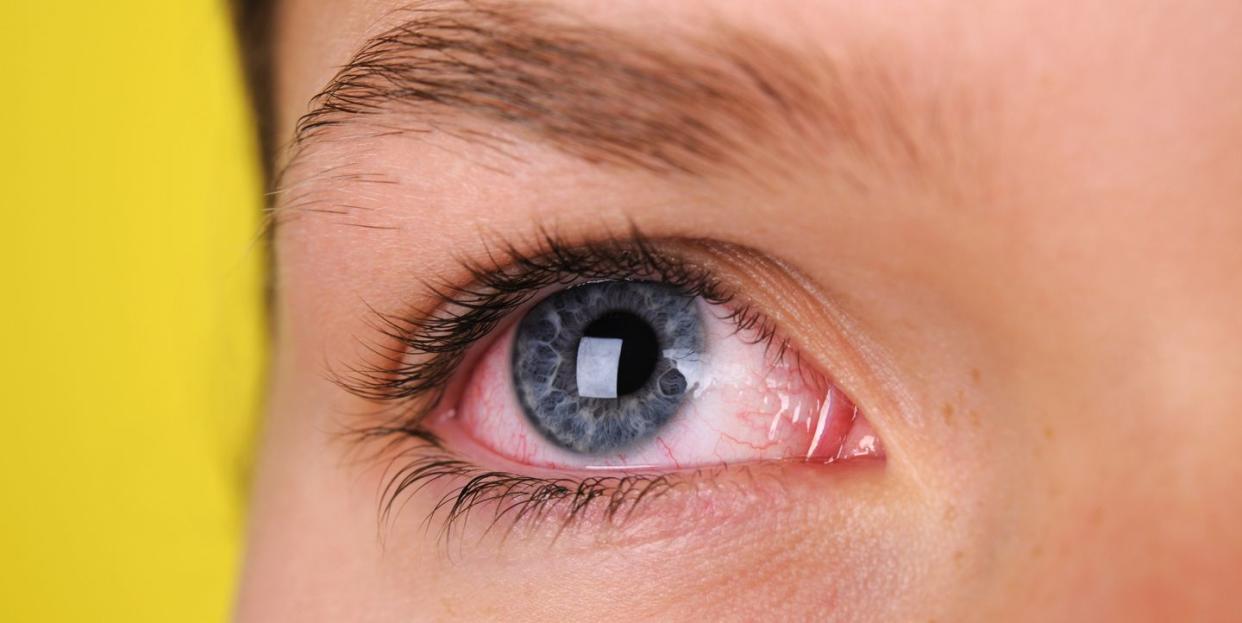Here’s What Your Bloodshot Eyes Mean—and When They Could Indicate Something Serious

It’s one thing to look in the mirror after rubbing your eyes to discover you’ve left them red and irritated. It’s another to have scleras—the technical name for the whites of your eyes—that are consistently a shade of pink for reasons unknown.
According to the American Academy of Ophthalmology (AAO), bright white scleras are healthy ones, and any kind of discoloration could indicate a problem. So if you find yourself asking “why are my eyes red” every other day, it may be time to see a professional. Keep reading to learn exactly what your red eyes mean, how to treat them, and how to differentiate between minor irritation and something more serious.
Common causes of red eyes
To put it simply, redness stems from irritation. “To fight off the irritant, your eyes make a substance called histamine,” explains Shivani Kamat, M.D., spokesperson for the AAO and assistant professor of ophthalmology at University of Texas Southwestern Medical Center. “This response triggers additional flow in the numerous tiny blood vessels on the outer surface of the eye, making the eyes look red or bloodshot.”
Dr. Kamat says there are an array of causes for such irritation. These are some of the most common:
Allergies
It’s no coincidence that your eyes grow redder when the local pollen count rises. They respond to irritants in the air with the aforementioned histamine, causing redness. Other potential irritants include dust, perfume, and chlorine from swimming pools.
Dry eye
Dry eye happens when your eyes don’t produce enough tears or tear film, which is the layer of moisture that coats and protects your eyes when you blink, according to the AAO. This makes the eyes more prone to redness and irritation, especially if you’re in a particularly dry climate, are exposed to smoke, or wear contact lenses for extended periods of time.
Lack of sleep
You often sport red eyes when you’re sleep deprived due to a lack of oxygen supplied to the eyes, which causes their blood vessels to dilate and appear red.
Pink eye
Also known as conjunctivitis, pink eye occurs when the conjunctiva of the eye become irritated or infected. Bacterial and viral conjunctivitis are easily spread and usually come with burning and a watery discharge, per the AAO. Depending on the type of pink eye, treatment varies, from waiting out the infection to antibiotic eye drops.
Broken blood vessels
Different from bloodshot eyes, a broken blood vessel or subconjunctival hemorrhage is marked by a bright red spot on the otherwise bright white of the eye. It happens when blood vessels in the eye break open, often caused by trauma to the eye, sneezing, coughing, or other types of straining. According to the AAO, although they appear scary, broken blood vessels often heal on their own.
Corneal ulcer
Also known as keratitis, a corneal ulcer is an open sore on the cornea often caused by infection or dry eye.
Other, more serious ocular conditions that may cause red eyes, per the AAO, are:
Glaucoma
Blepharitis
Cellulitis
Eye lymphoma
Herpes zoster (shingles)
Toxoplasmosis
Uveitis
Red eye treatments
It’s never a bad idea to see your eye doctor if you begin experiencing red eyes out of nowhere, but more often than not, Dr. Kamat says minor irritation can be taken care of at home. Her treatment tips are:
Use over-the-counter artificial tears. “These drops relieve irritation and wash allergens from the eye,” she says. You can use them up to four times per day. “If you use artificial tears more often, you should get preservative-free,” she adds.
Use antihistamine eye drops. “These drops help relieve itchiness,” says Kamat, “especially if you are prone to seasonal allergies.”
Try decongestant eye drops. But don’t rely on them too heavily. This type of drop reduces redness by narrowing the blood vessels and can cause “rebound redness” if overused, Kamat explains. They usually contain naphazoline, phenylephrine, oxymetazoline, or tetrahydrozoline as an active ingredient. Dr. Kamat recommends against using them for more than three days straight.
Cool compresses can help. Place a cool washcloth on your closed eyes a couple of times a day.
Avoid irritants. Stay away from smoke, fumes, pollen, dust, chlorine, or pet dander.
Wash your hands often. Also, avoid touching your eyes in general.
When to see a doctor for red eyes
If you’re having trouble narrowing down what’s causing sudden redness or irritation, Dr. Kamat recommends getting an eye exam right away. “If eye redness is accompanied by any degree of vision loss, contact your eye care provider immediately,” she adds. “Otherwise, if symptoms aren’t improving after one week of home remedies, see an eye doctor for diagnosis and individualized treatment options.”
You Might Also Like

